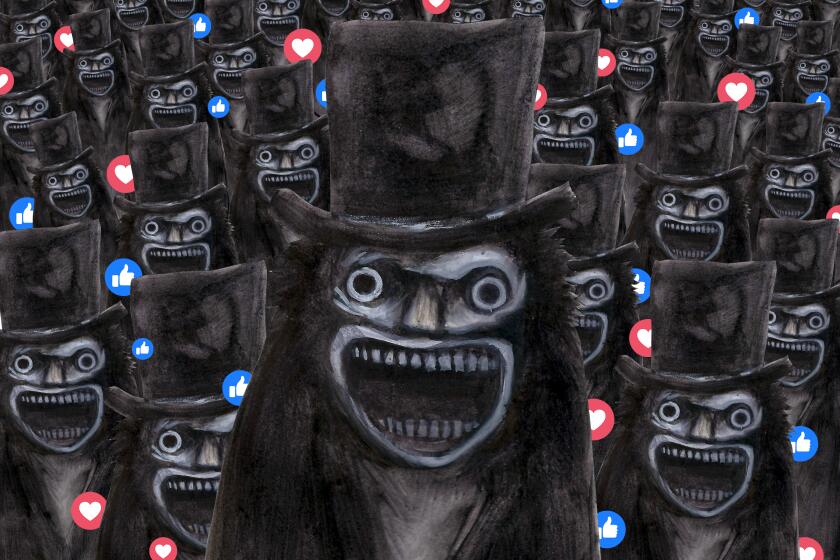What’s the meaning of ‘Trash Humpers’? Don’t ask Harmony Korine
When Harmony Korine’s “Trash Humpers” premiered on the festival circuit last fall, there was debate as to whether it should be considered an actual movie, some kind of bizarre art project or simply a hipper take on “Jackass”-styled pranksterism.
Made with outdated VHS-era home video equipment, the film, which opens in Los Angeles on Friday, follows four unnamed characters (played by Korine, his wife Rachel, Brian Kotzur and Travis Nicholson in unsettling old-people masks) as they wander through the back alleys and parking lots of Nashville, peeping in windows, drinking, breaking things, tap-dancing and, yes, rather vulgarly humping trash bins.
Though much of what happens at first seems random, character dynamics and a rough narrative do emerge. Akin to an amiably geriatric Manson Family, the Trash Humpers exist in their own bubble of rhetoric and mayhem and their repeated shouts of “make it, make it, don’t fake it” become both a taunt and a battle cry.
“People think of the film as almost like this provocation, an assault on reason and understanding,” said Korine, whose past directing credits include the equally challenging “Gummo” and “Julien Donkey-Boy,” recently by phone from his home in Nashville. “And maybe it is a little bit of all those things, I’m not sure. When I make a movie like this, I’m trying to make something that goes deeper than just a kind of logic or plain meaning.”
Among what can be explained about “Trash Humpers” is that the film was shot over two weeks last year only a few months before it began to screen at the fall festivals. The scenes are presented in the order in which they were filmed. Some scenes were made up on the spot, some had scripted material and others were semi-improvised from an outline. The film was edited by bouncing images between VCRs with technical glitches left in. Some of the movie plays like found footage, with certain segments rewinding on screen to a different part of the tape.
“Trash Humpers” features repeated images of babies, usually cheap plastic dolls, that are beaten with a hammer, dragged behind bicycles and generally mishandled. As the film shifts from its comedic early sections to something more and more unsettlingly sinister, near the end the female character seems to sneak into a house to snatch a live infant.
Korine and his wife had their own first child just a few months before shooting “Trash Humpers,” which raises two related question — is that their baby at the end, and would Korine describe the film as his response to the anxieties of being a new father?
“I think it’s best for me not to say,” he said. “I really couldn’t tell you, or I really wouldn’t want to say just because I feel like certain things are just best left unsaid, just watched and felt.”
“Trash Humpers” comes to theaters as the first film distributed theatrically by the record label Drag City, known for releasing music by such singularly eccentric musicians as Will Oldham, Bill Callahan and Joanna Newsom.
“Harmony approached us with this,” Drag City co-owner Dan Koretzky said via e-mail, “and I can only assume he wanted someone with a uniquely inexperienced and passionate ineptitude to handle this film for him. We are extremely grateful that he chose us to work on this. It’s literally impossible to fail, and we always find those the most exciting projects to be a part of.”
For his part, Korine now recognizes that “Trash Humpers” falls well outside what even most art-house distributors will put in theaters these days, although that wasn’t what he set out to make.
“I always think differently about my work from the way it is perceived generally,” Korine said. “When I made the movie, it was my attempt to make my most commercial film, without any question. I wanted the movie to play in shopping malls, I felt like ‘Trash Humpers’ was the kind of thing that Miley Cyrus could endorse. I felt like it spoke to the tween set, like they would understand what was happening. It’s not a movie in the old sense of the word, it was something perhaps newer that they could identify with.
“Then when I showed the film everyone told me there is no way this will play in megaplexes, and so you just deal with it.”
More to Read
Only good movies
Get the Indie Focus newsletter, Mark Olsen's weekly guide to the world of cinema.
You may occasionally receive promotional content from the Los Angeles Times.










